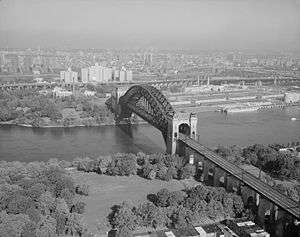Hell Gate
Coordinates: 40°46′54″N 73°55′25″W / 40.781698°N 73.923516°W



Hell Gate is a narrow tidal strait in the East River in New York City in the US. It separates Astoria, Queens from Randall's and Wards Islands (formerly two separate islands, now joined by landfill).[1]
Etymology
The name "Hell Gate" is a corruption of the Dutch phrase Hellegat (it first appeared on a Dutch map as Helle Gadt[2]), which could mean either "bright strait" or "clear opening",[3] and it was originally applied to the entirety of the East River. Dutch explorer Adriaen Block, the first European known to have navigated the strait, described it in his journals during his 1614 voyage aboard the Onrust. Hellegat is a fairly common toponym for waterways in the Low Countries, with at least 20 separate examples.[4] Because explorers found navigation hazardous in this New World place of rocks and converging tide-driven currents (from the Long Island Sound, Harlem River strait, Upper Bay of New York Harbor, and lesser channels, some of which have been filled), the Anglicization stuck.[5]
History
In October 1776, Admiral Howe sailed some of the British fleet through the strait, an action which was considered reckless at the time.[6]
In 1851, the U.S. Army Corps of Engineers began to clear obstacles from the strait with explosives; the process would last 70 years.[7] On September 24, 1876, the Corps used 50,000 pounds (23,000 kg) of explosives to blast the dangerous rocks, which was followed by further blasting work.[8] On October 10, 1885, the Corps carried out the largest explosion in this process, annihilating Flood Rock with 300,000 pounds (140,000 kg) of explosives.[9] The blast was felt as far away as Princeton, New Jersey[9] and sent a geyser of water 250 feet (76 m) in the air.[10] The blast has been described as "the largest planned explosion before testing began for the atomic bomb",[10] although the detonation at the Battle of Messines in 1917 was larger. Rubble from the detonation was used in 1890 to fill the gap between Great Mill Rock and Little Mill Rock, merging the two islands into a single island, Mill Rock.[9] The incident inspired the climactic conclusion of Bram Stoker's novel The Lair of the White Worm.
_pg944_FLOOD_ROCK_EXPLOSION_AT_HELL_GATE_IN_OCTOBER%2C_1885._RAND_DRILL_COMPANY'S_DRILLS_AND_EXPLOSIVES.jpg)
By the late 19th century, hundreds of ships, including HMS Hussar, had sunk in the strait. It was spanned in 1917 by the New York Connecting Railroad Bridge (now called the Hell Gate Bridge), which connects Wards Island and Queens. The bridge provides a direct rail link between New England and New York City.[11] In 1936, it was spanned by the Triborough Bridge (officially Robert F. Kennedy Bridge since 2008), allowing vehicular traffic to pass among Manhattan, the Bronx, and Queens.[12]
In popular culture
Film
- Hell Gate: The Watery Grave (1977), is a 50-minute documentary film, narrated by Alexander Scourby, which covers many aspects of the waterway's history, including the clearing of the channel, the building of Hell Gate Bridge, and the PS General Slocum steamship disaster.
- Under Hellgate Bridge (1999), directed by Michael Sergio, is a crime drama/thriller film, set in Queens, that features the bridge.[13]
Literature
- In James Fenimore Cooper's historical fiction novel The Water-Witch, or, The Skimmer of the Seas (first published in New York in 1830[14]), Hell Gate serves as the scene for an exciting pursuit of the brigantine Water Witch by the HMS Coquette[15][16] The Water Witch is captained by Thomas Tiller, an adventurous sailor with a romantic flair, and the HMS Coquette by Captain Cornelius van Cuyler Ludlow, a principled young officer in the Royal Navy and a native of New York.
See also
References
- ↑ Jackson, Kenneth T., ed. (1995). The Encyclopedia of New York City. New Haven, Conn.: Yale University Press. p. 538. ISBN 0-300-05536-6.
- ↑
- ↑ Gannett, Henry (1905). The Origin of Certain Place Names in the United States. Govt. Print. Off. p. 154.
- ↑ Van Dyck, Vic. "Hellegat en Hellegat" (in Dutch). Retrieved November 19, 2011.
- ↑ "Hell Gate". New York History. Retrieved April 15, 2012.
- ↑ "Permanent Revolution". New York magazine. September 10, 2012.
- ↑ "NOAA 200th Collections: Hell Gate and Its Approaches nautical chart from 1851". National Oceanic and Atmospheric Administration. Retrieved April 12, 2009.
- ↑ "Rendering Hell-Gate Rocks; The Submarine Mine Exploded". The New York Times. September 25, 1876. p. 1. Retrieved November 19, 2011.
- 1 2 3 "Mill Rock Island". New York City Department of Parks and Recreation. June 6, 2001. Retrieved April 12, 2009.
- 1 2 Whitt, Toni (June 2, 2006). "The East River is Cleaner Now. The Water Birds Say So.". The New York Times. Retrieved April 12, 2009.
- ↑ Anderson, Steve. "Hell Gate Bridge". NYCRoads. Retrieved April 13, 2010.
- ↑ Caro, Robert (1974). The Power Broker. New York: Vintage Books. p. 386. ISBN 0-394-72024-5.
- ↑ "Reviews of Under Hellgate Bridge". Rotten Tomatoes. 1999.
- ↑ "Goodreads book description of The Water-Witch by James Fenimore Cooper". The Water Witch.
- ↑ Cooper, James Fenimore (1836). The Water-Witch, or, The Skimmer of the Seas. Carey, Lea, & Blanchard.
- ↑ Baym, Max I. & Matenko, Percy (January 1970). "The Odyssey of The Water-Witch and a Susan Fenimore Cooper Letter". New York History. LI (1). New York State Historical Association. pp. 33–41.
External links
| Wikisource has original text related to this article: |